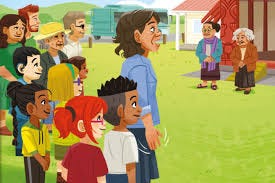At The Marae:
Ministry of Education Ready to Read Phonics Plus reader. Words by Maggie Boston and Jennifer Smith. Illustrations by Stevie Mahardhika
“The small student reader version of At the Marae will not be reprinted. The Ministry has made this decision due to the high number of words that appear in the text in te reo Māori. Te reo Māori vowel sounds are different than English making this book less appropriate for students to practice decoding words containing grapheme-phoneme correspondences that have already been taught.”
Too many Māori words? Am I overreacting or does this feel like a slow slide into culturicide?
The paragraph above was in a letter accompanying some Big Books that arrived at school last week. Yes, it will be good for teachers to have a large copy of At the Marae to use for shared reading in class, but in general it is the small readers that children engage with more often: in their guided reading group, in their independent book boxes and for ‘homework’ reading.
It’s not quite book burning but still a sad sign of where we might be heading as an education system. Children love seeing themselves, their home contexts, languages and familiar experiences reflected in their readers. This increases their engagement. Engagement increases achievement.
If the Ministry wasn’t solely promoting such a reductionist, one-size-fits-all approach to reading then the presence of more phonetic, consistently pronounced, non-English words would not be a ‘problem’. Students would use their prior knowledge of kupu Māori and their knowledge of the context of the story - for many this would be a context that reflects their cultural capital. They might use the picture clues and the grammar, or sentence syntax, to help decode the unknown words. They might use strategies such as rerunning, cross-checking and self-correction. And yes: they might use their sound knowledge and visual clues such as the grapheme-phoneme correspondence. It’s likely they would use a combination of the above as reading is a complex activity.
Does this message from the Ministry suggest that we will be seeing fewer kupu Māori in our children’s reading resources? And is this indicative of government priorities across a range of classroom materials? Last year we saw te reo Māori training for teachers cut to fund white-washed maths workbooks from overseas. [1]
How is this culturally sustaining pedagogy? How is this moving us ‘Beyond Whiteness’? As Dr Ann Milne says in her recently released book: ‘Whiteness is not just about colour-its a mindset that impacts everything from discipline practices to curriculum choices’ [2].
We are walking backwards into the sixties and seventies with each stroke of the twink.
[2]




Hi Lynda
At least two parties, the fascist tails wagging the limp, corporate dog, are hell-bent on the erasure of Māori language and Māori tikanga in as many spheres as they can. There is not linguistic basis for this decision. Māori vowel sounds are pretty close to Spanish. I don't think you find these faceless individuals having problems with a picture book containing words like taco and tortilla.
Yep. Its amazing how fast and across how many different spaces this is happening